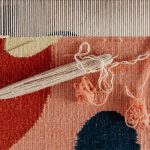Are you interested in learning how to weave silk fabric? Look no further! In this article, we will guide you through the step-by-step process of creating beautiful silk weavings.
From selecting the right silk yarn to troubleshooting common issues, we’ve got you covered. With our clear and detailed instructions, you’ll be able to set up your loom, choose weaving techniques, and create stunning patterns and designs in no time.
So grab your materials and let’s get started!
Table of Contents
Selecting the Right Silk Yarn
When selecting the right silk yarn, it’s important to consider the desired weight and texture of the fabric. Choosing silk yarn can be overwhelming with the various options available, but understanding the properties of silk yarn will help you make an informed decision.
Silk yarn comes in different weights, ranging from lightweight to heavy. If you want a delicate, lightweight fabric, opt for a fine silk yarn. On the other hand, if you desire a more substantial fabric, go for a heavier silk yarn. Additionally, consider the texture you want to achieve. Silk yarn can be smooth and shiny, or it can have a more textured appearance. Decide whether you want a sleek and glossy fabric or a fabric with more depth and character.
Silk yarn has unique properties that make it ideal for weaving. It is known for its strength, durability, and lustrous appearance. Silk is also naturally breathable, making it comfortable to wear. Another important property of silk yarn is its ability to absorb moisture, which helps regulate body temperature. Keep these properties in mind when selecting silk yarn for your weaving project.
Setting up the Loom for Silk Weaving
When setting up your loom for silk weaving, there are three key points to consider: the loom assembly steps, silk thread tension, and weaving techniques.
First, you will need to follow the specific assembly steps for your loom to ensure it is properly set up and ready to use.
Next, achieving the correct silk thread tension is crucial for producing high-quality woven fabric.
Finally, understanding various weaving techniques will allow you to create different patterns and textures in your silk fabric.
Loom Assembly Steps
To assemble the loom, you’ll need to follow these step-by-step instructions. First, make sure you have all the necessary silk weaving tools, such as a shuttle, heddles, and a reed. These tools are essential for creating a smooth and efficient weaving process. Next, start by attaching the warp beam to the loom frame, ensuring it is securely fastened. Then, thread the warp yarn through the heddles and the reed, making sure it is evenly spaced. After that, attach the cloth beam to the loom frame, ensuring it is parallel to the warp beam. Finally, tie the warp yarn to the cloth beam and adjust the tension as needed. With these simple steps, you’ll have your loom assembled and ready for weaving beautiful silk fabric.
| Tools | Purpose |
|---|---|
| Shuttle | To carry the weft yarn across the warp threads |
| Heddles | To control the movement of the warp threads |
| Reed | To beat the weft yarn into place |
| Warp Beam | To hold the warp threads |
Silk Thread Tension
Adjusting the tension of the silk thread is essential for ensuring smooth and efficient weaving on the loom. To maintain the quality of your silk thread and prevent any disruptions during the weaving process, it is important to regularly check and adjust the tension.
Start by inspecting the thread for any signs of wear or damage. Replace any worn-out sections with fresh silk thread from reliable suppliers.
Next, locate the tension adjustment mechanism on your loom. This could be a tension knob or lever. Gradually increase or decrease the tension until the thread feels taught but not overly tight. It’s crucial to find the right balance to ensure even and consistent weaving.
Weaving Techniques Explained
Mastering different weaving techniques will enable you to create intricate and unique textile designs. By understanding and practicing these techniques, you can unlock the full potential of silk fabric and create stunning pieces.
Here are five essential weaving techniques that every silk weaver should know:
-
Plain Weave: The simplest and most basic technique, where the weft thread goes over and under each warp thread.
-
Twill Weave: This technique creates diagonal lines on the fabric and is often used to add texture and depth to designs.
-
Satin Weave: By floating the weft threads over multiple warp threads, a smooth and lustrous fabric with a luxurious sheen is created.
-
Leno Weave: This technique involves twisting pairs of warp threads together, producing an open and airy fabric with a unique drape.
-
Tapestry Weave: Perfect for creating intricate designs, this technique allows you to weave different colored threads to form patterns and pictures.
To enhance your weaving experience, make sure to have the right tools such as a loom, shuttles, and weaving needles. Additionally, experimenting with silk fabric dyes can add vibrant colors and a personal touch to your creations.
Preparing the Warp for Silk Fabric
First, you’ll need to carefully measure and cut the silk threads for the warp of your fabric. The warp is the foundation of your weaving, running vertically on the loom. To ensure accuracy, use a measuring tape and sharp scissors to cut the threads to the desired length.
Next, it’s important to prepare the warp by winding it onto a warping board or a warping mill. This process helps to evenly distribute the threads and prevents tangling. As you wind, make sure to maintain tension and keep the threads parallel to each other.
Once the warp is prepared, you can move on to the next step: silk fabric dyeing. There are various methods you can choose from to dye your silk fabric. One popular technique is immersion dyeing. In this method, you fully submerge the silk into a dye bath and let it soak until the desired color is achieved.
Another technique is hand painting, where you apply the dye directly onto the fabric using brushes or squeeze bottles. This allows for more precise and intricate designs. Alternatively, you can try tie-dyeing or shibori techniques to create unique patterns and textures on your silk fabric.
Choosing the Weaving Technique for Silk
Now that you have prepared the warp for your silk fabric, it’s time to choose the weaving technique that will bring your design to life. This decision is crucial as it will determine the overall appearance and texture of your finished fabric.
To help you make an informed choice, here are some key points to consider:
-
Silk Weaving Tools: Before you begin, gather the necessary tools for weaving silk. These may include a loom, shuttles, bobbins, and a temple. These tools will ensure smooth and efficient weaving.
-
Historical Significance of Silk Weaving: Silk weaving has a rich history that dates back thousands of years. It has been practiced in various cultures around the world, and each has its unique techniques and patterns. Take inspiration from these historical traditions and incorporate them into your design.
-
Weaving Styles: Explore different weaving styles such as plain weave, twill weave, satin weave, and jacquard weave. Each style offers different characteristics, from simple and elegant to intricate and textured.
-
Pattern Selection: Consider the pattern you want to create. Traditional motifs, geometric designs, or floral patterns can all be woven into silk fabric. Choose a pattern that complements your design vision.
-
Experimentation: Don’t be afraid to experiment with different weaving techniques and patterns. This will allow you to create unique and innovative designs that showcase the beauty and versatility of silk fabric.
Creating Patterns and Designs in Silk Weaving
To bring your silk design to life, consider experimenting with various patterns and designs in your weaving technique. Creating unique designs in silk weaving allows you to showcase your creativity and add a personal touch to your fabric. One way to achieve this is by using different weaving patterns, such as twill, satin, or plain weave, to create texture and visual interest. Another option is to incorporate patterns into your design by alternating colors or using different yarn thicknesses.
Experimenting with color combinations is another effective way to create unique designs in silk weaving. By combining different colors, you can create contrast, depth, and visual impact in your fabric. Consider using complementary colors, such as blue and orange or purple and yellow, to make your design stand out. You can also experiment with monochromatic color schemes, using various shades of the same color to create a subtle and elegant look.
To help you visualize the possibilities of creating patterns and experimenting with color combinations in silk weaving, here is a table showcasing different examples:
| Pattern/Design | Description |
|---|---|
| Stripes | Alternating vertical lines of different colors |
| Checkered | A pattern of small squares in contrasting colors |
| Floral | Depicting flowers or plants in various colors |
Troubleshooting Common Issues in Silk Weaving
If you encounter any issues while working on your silk design, there are common troubleshooting techniques you can try.
Weaving silk fabric can be a delicate process, and problems may arise. Here are some tips to help you troubleshoot weaving issues and solve silk fabric problems:
-
Check the tension: Ensure that the tension on your loom is properly adjusted. Too tight or too loose tension can cause weaving issues, such as puckering or uneven fabric.
-
Inspect the warp: Examine the warp threads for any knots, tangles, or broken ends. These can lead to weaving problems, such as skipped threads or snags in the fabric.
-
Adjust the weft: If you notice that the weft threads are not evenly packed, adjust the tension on the weft. Uneven weft tension can result in a wavy or distorted fabric.
-
Fix broken threads: If a thread breaks during weaving, tie a new thread to the broken end and continue weaving. Make sure to secure the knot properly to avoid unraveling.
-
Clean the shuttle: If you are experiencing issues with the shuttle, such as it getting stuck or not gliding smoothly, clean it thoroughly. Dust or debris can hinder its movement.
By following these troubleshooting techniques, you can overcome common issues in silk weaving and achieve the desired results in your fabric.
Happy weaving!
Finishing Techniques for Silk Fabric
After weaving your silk design, you can use various finishing techniques to enhance the appearance and durability of the fabric. These techniques include silk fabric dyeing and embellishment methods. By dyeing your silk fabric, you can add vibrant colors and unique patterns to your design. There are different dyeing techniques you can choose from, such as immersion dyeing, hand painting, and tie-dyeing. Each technique gives a different effect, allowing you to create a truly one-of-a-kind piece.
In addition to dyeing, you can also embellish your silk fabric using various methods. Embellishments can add texture, dimension, and visual interest to your design. Some popular embellishment techniques for silk fabric include embroidery, beading, and appliqué. Embroidery can be done by hand or machine, and it allows you to add intricate designs and patterns to your fabric. Beading involves sewing beads onto the fabric, creating a shimmering effect. Appliqué is the process of attaching fabric shapes onto a base fabric, creating a layered and textured look.
By using these silk fabric dyeing techniques and embellishment methods, you can transform your woven silk fabric into a stunning and unique piece of art. The table below provides a visual representation of these techniques and their effects:
| Technique | Effect |
|---|---|
| Dyeing | Adds vibrant colors and patterns |
| Embroidery | Adds intricate designs and patterns |
| Beading | Creates a shimmering effect |
| Appliqué | Adds texture and layers |
These finishing techniques allow you to personalize your silk fabric and make it truly your own. So go ahead, unleash your creativity and take your silk weaving to the next level!
Caring for and Maintaining Silk Weavings
Now that you have learned about the finishing techniques for silk fabric, it’s important to know how to properly care for and maintain your silk weavings.
Silk is a delicate and luxurious fabric that requires special attention to keep it in its best condition. Here are some tips to help you care for your silk garments and store your silk fabric:
-
Handwashing: When it comes to cleaning silk garments, always opt for handwashing instead of machine washing. Use a mild detergent and lukewarm water to gently cleanse the fabric. Avoid rubbing or twisting the silk as it can damage the fibers.
-
Drying: After washing, avoid wringing out excess water from the silk fabric. Instead, gently squeeze it to remove the water and then lay it flat on a clean towel to air dry. Avoid direct sunlight as it can fade the colors.
-
Ironing: To remove wrinkles from silk garments, use a low heat setting on your iron or a steamer. Always iron on the reverse side of the fabric to prevent any damage.
-
Storage: When storing silk fabric, it’s important to keep it away from direct sunlight and moisture. Fold the fabric neatly and place it in a breathable storage bag or wrap it in acid-free tissue paper to protect it from dust and insects.
-
Avoid contact with chemicals: Silk is sensitive to chemicals, so avoid spraying perfume or using hairspray near your silk garments. Also, be cautious when wearing silk while applying skincare products or makeup.
Conclusion
In conclusion, weaving silk fabric requires careful consideration and attention to detail. By selecting the right silk yarn and setting up the loom properly, you can ensure a smooth weaving process.
Preparing the warp and choosing the weaving technique are crucial steps in creating beautiful silk patterns and designs. Troubleshooting common issues and using proper finishing techniques will help you achieve a high-quality silk fabric.
Lastly, proper care and maintenance will ensure the longevity of your silk weavings. With practice and patience, you can master the art of weaving silk fabric.
- How to Get Wrinkles Out of Acetate Fabric Without an Iron - June 24, 2025
- What Is Acetate Satin? A Guide to This Luxurious Fabric - June 24, 2025
- Does Acetate Fabric Wrinkle Easily? Tips for a Crease-Free Look - June 24, 2025






